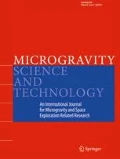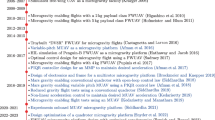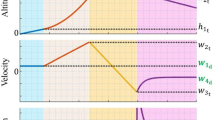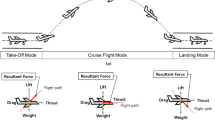Abstract
This work establishes multirotor unmanned aerial vehicles (UAVs) as viable microgravity platforms. Towards this, a vertical microgravity enabling maneuver suitable for multirotors, control and automation strategies, and techniques to enhance the performance of multirotors as microgravity platforms are proposed. Successful microgravity enabling maneuvers are performed to show the proposed control and automation strategies’ effectiveness using two multirotor test vehicles. Further, this paper shows that all the existing multirotors can be microgravity platforms and provide a method to calculate the maximum microgravity duration a multirotor can provide. Finally, experiments are conducted onboard one of the multirotors executing a microgravity enabling maneuver to observe the effect of microgravity on liquid level in a capillary and liquid meniscus shape in a glass cuvette. These experiments and the microgravity enabling flight tests demonstrate that multirotors can be turned into microgravity platforms. To the best of the author’s knowledge, the two UAVs presented in this paper are the first multirotor UAVs to achieve microgravity and the first UAVs—fixed-wing or rotary—to conduct onboard experiments in microgravity.





















Similar content being viewed by others
Notes
The definitions of fwof the microgravity platform’s performance measures such as g-time, g-level, g-quality, and g-jitters are provided in Appendix-A.
Lower the g-level, better the performance of a microgravity platform.
Note that these variables can belong to more than one class, or they may belong to none.
The quadrotor’s block diagram is not explicitly provided, as the only difference in the quadrotor compared to the hexrotor is the absence of inverted propulsion units.
This automation strategy also consists of a safety mechanism to shut down all the rotors, which will trigger in case of a communication loss or loss of stability to avoid any potential hazard during an uncontrolled flight.
For an in-depth detail of this acceleration control law, readers may refer to our previous article (Kedarisetty and Manathara 2019).
The experienced acceleration by the multirotor is calculated as \(g_z = a_z + g,g_y = a_y, g_x = a_x\).
References
Afman, J.P., Franklin, J., Mote, M.L., Gurriet, T., Feron, E.: On the Design and Optimization of an Autonomous Microgravity Enabling Aerial Robot. (2016) arXiv e-prints, art. arXiv:1611.07650
Air Transport Circular. Office of the Director General of Civil Aviation, Government of India (2016)
Beitz, E., Güttler, C., Blum, J., Meisner, T., Teiser, J., Wurm, G.: Low-velocity Collisions of Centimeter-sized Dust Aggregates. Astrophys J 736(1), 1–11 (2011)
Brandt, J., Selig, M.: Propeller Performance Data at Low Reynolds Numbers. In Proc. of AIAA Aerospace Sciences Meeting including the New Horizons Forum and Aerospace Exposition, pages 1–18, Orlando, Florida, USA (2011)
Brigos, M., Perez-Poch, A., Alpiste, F., Torner, J., Alonso, D.V.G.: Parabolic Flights with Single-Engine Aerobatic Aircraft: Flight Profile and a Computer Simulator for Its Optimization. Microgravity Sci Tech 26(4), 229–239 (2014)
Chauhan, S., Patil, C., Sinha, M., Halder, A.: Fuzzy State Noise-driven Kalman Filter for Sensor Fusion. Institution of Mechanical Engineers, Part G: J Aerospace Eng 223(8), 1091–1097 (2009)
de Crombrugghe, G., Pletser, V: Emerging Microgravity Platforms and their Capabilities Compared to the Traditional Offering. In Proc. of International Astronautical Congress, pages 25–29, Adelaide, Australia (2017)
Higashino, S., Kozai, S.: Automatic Microgravity Flight System and Flight Testing Using a Small Unmanned Aerial Vehicle. Japan Soc Microgravity Appl 27(1), 3–10 (2010)
Hofmeister, P.G., Blum, J.: Parabolic Flights home. Microgravity Sci tech 23(2), 191–197 (2011)
Karmali, F., Shelhamer, M.: The Dynamics of Parabolic Flight: Flight Characteristics and Passenger Percepts. Acta Astronautica 63(5), 594–602 (2008)
Kedarisetty, S., Manathara, J.G.: Acceleration Control of a Multirotor UAV Towards Achieving Microgravity. Aerospace Syst 2(2), 175–188 (2019)
Kraeger, A., van Paassen, R.: Micro-and Partial Gravity Atmospheric Flight. In Proc. of AIAA Atmospheric Flight Mechanics Conference and Exhibit, pages 1–11, California, USA (2002)
Kraeger, A.M.: Free-wing Unmanned Aerial Vehicle as a Microgravity Facility. J Guid Cont Dyna 29(3), 579–587 (2006)
Leishman, R.C., Macdonald, J.C., Beard, R.W., McLain, T.W.: Quadrotors and Accelerometers: State Estimation with an Improved Dynamic Model. IEEE Cont Syst Mag 34(1), 28–41 (2014)
Osborne, J.R., Lanza, M.V.A., Desclaux, D.F., Goswami, N., Alonso, D.V.G., Moser, M., Grote, V., Garcia-Cuadrado, G., Perez-Poch, A.: Effect of Mental Arithmetic on Heart Rate Responses During Parabolic Flights: The Barcelona Zero-G Challenge. Microgravity Sci Tech 26(1), 11–16 (2014)
Perez-Poch, A., González, D.V., López, D.: Hypogravity Research and Educational Parabolic Flight Activities Conducted in Barcelona: A New Hub of Innovation in Europe. Microgravity Sci Tech 28(6), 603–609 (2016)
Pletser, V.: Short Duration Microgravity Experiments in Physical and Life Sciences During Parabolic Flights: The First 30 ESA Campaigns. Acta Astronautica 55(10), 829–854 (2004)
Pletser, V., Frischauf, N., Cohen, D., Foster, M., Spannagel, R., Szeszko, A., Laufer R.: First Middle East Aircraft Parabolic Flights for ISU Participant Experiments. Microgravity Sci Tech 29(3), 209–219 (2017a)
Pletser, V., Frischauf, N, Laufer, R., Cohen, R.: Parabolic Flights with Gliders as an Innovative Low Cost Platform for Microgravity and Hypergravity Research. In Proc. of International Astronautical Congress, pages 1–5, Adelaide, Australia (2017b)
Rogers, M.J., Vogt, G.L., Wargo M.J.: Microgravity: A Teacher’s Guide with Activities in Science, Mathematics, and Technology (1997)
Siddhardha, K.: Autonomous Reduced-gravity Enabling Quadrotor Test-bed: Design, Modelling and Flight Test Analysis. Aerospace Sci Tech 86, 64–77 (2019)
Smirnov, N., Nikitin, V., Skryleva, E.: Microgravity Investigation of Seepage Flows in Porous Media. Microgravity Sci Tech 31(5), 629–639 (2019)
Takahashi, F., Katta, V.R., Hicks, M.C.: Cool-Flame Burning and Oscillations of Envelope Diffusion Flames in Microgravity. Microgravity Sci tech 30(4), 339–351 (2018)
Thomas, V., Prasad, N., Reddy, C.: Microgravity Research Platforms - A study. Curr Sci 79(3), 336–340 (2000)
Acknowledgements
I thank Mr. Ajo Joseph, the multirotor pilot, for his time and patience. I also thank Prof. Amit Kumar and Prof. A. Sameen of Indian Institute of Technology Madras for allowing me to use their laboratories to conduct experiments. I am grateful for the lab members who helped me to set up experiments. Finally, I thank Dr. Joel George Manathara of Indian Institute of Technology Madras for his suggestions on the work presented in this paper.
Author information
Authors and Affiliations
Corresponding author
Additional information
Publisher’s Note
Springer Nature remains neutral with regard to jurisdictional claims in published maps and institutional affiliations.
Appendix - A
Appendix - A
The performance of a microgravity platform is quantified using the following measures.
-
a)
g-time: It is the duration for which the microgravity platform can experience microgravity.
-
b)
g-level: It is the mean acceleration experienced by the microgravity platform during the g-time
-
c)
g-quality: It is the root mean square deviation of the experienced acceleration about the g-level value
-
d)
g-jitters: It is the amplitude and frequency of the acceleration experienced by the microgravity platform during the g-time. Unlike the other microgravity performance measures, g-jitters is a graphical measure that provides the amplitude of the acceleration experienced by the microgravity platform at different frequencies.
Rights and permissions
About this article
Cite this article
Siddhardha, K. Microgravity Enabling Multirotors. Microgravity Sci. Technol. 33, 36 (2021). https://doi.org/10.1007/s12217-021-09889-1
Received:
Accepted:
Published:
DOI: https://doi.org/10.1007/s12217-021-09889-1




